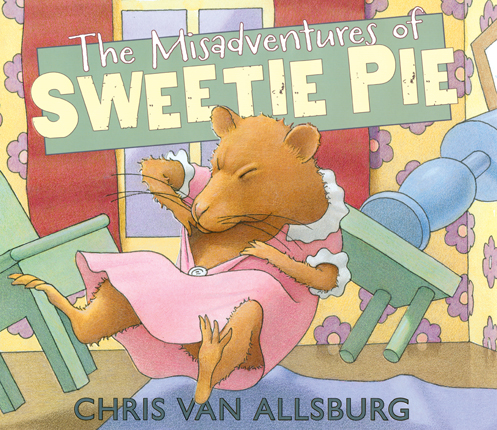| Misadventures of Sweetie Pie Author: Van Allsburg, Chris | ||
| Price: $6.50 | ||
Summary:
Sweetie Pie escapes the confines of his hamster cage (and several insufferable owners) to find a new home in the wild.
Video Preview:
| Accelerated Reader Information: Interest Level: LG Reading Level: 4.20 Points: .5 Quiz: 170386 |
Reviews:
Kirkus Reviews (09/01/14)
School Library Journal (09/01/14)
Booklist (10/01/14)
The Bulletin of the Center for Children's Books (M) (01/15)
The Hornbook (00/11/14)
Full Text Reviews:
School Library Journal - 09/01/2014 PreS-Gr 2—Master storyteller Van Allsburg's latest children's book is about a frustrated hamster. He is bought by a girl and given the name Sweetie Pie, but she quickly grows tired of him and tries to sell him. As Sweetie Pie is passed from child to child, he yearns for the freedom of nature and a life uncaged. But his caretakers are unfortunately negligent; he's overfed, frightened by a large dog, abused inside an exercise ball, and finally forgotten in the snow. Children looking for a cute story about a misunderstood hamster will find this title bittersweet, in the vein of The Velveteen Rabbit. The story might serve as a cautionary tale for children who need lessons about how to treat their pets, but the more dismal scenes make it less than ideal for storytime. Van Allsburg's backgrounds and designs feel much more simplistic than previous works, and his normal sepia color scheme has been traded in for bright colors and limited shadow, keeping the book's tone as lighthearted as possible given its serious nature. Although a departure from his other masterpieces like Jumanji (1991) and Polar Express (1985, both Houghton Harcourt), Misadventures of Sweetie Pie is an additional purchase for most collections.—Peter Blenski, Greenfield Public Library, WI - Copyright 2014 Publishers Weekly, Library Journal and/or School Library Journal used with permission.
Booklist - 10/01/2014 Sweetie Pie is the last hamster chosen at the pet store, but he remains cautiously optimistic about what lies ahead after a little girl takes him home. What he doesn’t know yet is that Pigtails is the first of a series of unreliable children who will be his caretaker. Each child loses interest in succession, distracted by a new computer or a bigger dog, trading Sweetie Pie from one house to the next until, at last, he is left out in his cage in a blizzard, forgotten. He manages to escape, though, and finds happiness with an adopted family of squirrels, as the children turn their (temporary) attentions to a new class guinea pig. Van Allsburg’s gentle shading and soft palette are at odds with the story’s raw undercurrent; the narrative’s direct, incidental prose offers a harsh indictment of the children’s behavior, even as the fine character work, especially for Sweetie Pie himself, adds nuance and tenderness. Older children will awaken to the responsibilities of pet care and the deeper values of empathy and affection. - Copyright 2014 Booklist.
Bulletin for the Center... - 01/01/2015 Poor Sweetie Pie: the hamster finally leaves the petshop for a series of indifferent owners, and even his escape in a plastic hamster ball just leads him to another problem placement. Finally he’s made a class pet, but his weekend caretaker lets him escape into the wintry outdoors; though the class is sure Sweetie Pie died in the snow, he actually hibernated, and he now lives happily in a tree with his squirrel friends. The story is grimly purposive and yet not very clear; since there are no decent models for animal caretaking to make it a lesson in husbandry, it seems to be just an old-school moral tale focusing here on the evils of animal domestication-but the solution offered isn’t likely to work out so well for most domestic hamsters, and the plot lacks the peaks and valleys that make animal welfare sagas like Black Beauty so absorbing. The smooth, softly shaded colored pencil and watercolor art sets the drama against bland, innocent backdrops, which makes the contrast of the anthropomorphized hamster’s distress and the savagery of the humans all the more alarming, especially in the hamster’s-eye view of threats such as the snarling dog. While this might be used as a scared-straight tool for encouraging better animal treatment, it’s a pretty blunt instrument likely to cause some collateral damage with its unhappy audience. DS - Copyright 2015 The Board of Trustees of the University of Illinois.



